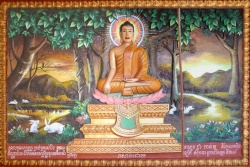Difference between revisions of "Aṣṭasāhasrikā Prajñāpāramitā"
| Line 10: | Line 10: | ||
[[Aṣṭasāhasrikā Prajñāpāramitā]] | [[Aṣṭasāhasrikā Prajñāpāramitā]] | ||
| − | {{Wiki|Western}} [[scholars]] have [[traditionally]] considered the earliest [[sūtra]] in the [[Prajñāpāramitā]] class to be the [[Aṣṭasāhasrikā Prajñāpāramitā Sūtra]] or "[[Perfection of Wisdom in 8,000 Lines]]", which was probably put in [[writing]] in the 1st century BCE | + | {{Wiki|Western}} [[scholars]] have [[traditionally]] considered the earliest [[sūtra]] in the [[Prajñāpāramitā]] class to be the [[Aṣṭasāhasrikā Prajñāpāramitā Sūtra]] or "[[Perfection of Wisdom in 8,000 Lines]]", which was probably put in [[writing]] in the 1st century BCE. |
| − | Additionally, a number of [[scholars]] have proposed that the [[Mahāyāna]] [[Prajñāpāramitā]] teachings were first developed by the [[Caitika]] subsect of the [[Mahāsāṃghikas]]. They believe that the [[Aṣṭasāhasrikā Prajñāpāramitā Sūtra]] originated amongst the southern [[Mahāsāṃghika]] schools of the {{Wiki|Āndhra}} region, along the [[Kṛṣṇa]] [[River]]. These [[Mahāsāṃghika]]'s had two famous [[monasteries]] near the [[Amarāvati]] and the [[Dhānyakataka]], which gave their names to the schools of the [[Pūrvaśailas]] and the [[Aparaśailas]]. Each of these schools had a copy of the [[Aṣṭasāhasrikā Prajñāpāramitā Sūtra]] in {{Wiki|prakrit}}. [[Guang Xing]] also assesses the [[view]] of the [[Buddha]] given in the [[Aṣṭasāhasrikā Prajñāpāramitā Sūtra]] as [[being]] that of the [[Mahāsāṃghika]]'s. {{Wiki|Edward Conze}} estimates that this [[sūtra]] originated around 100 BCE. | + | This {{Wiki|chronology}} is based on the [[views]] of {{Wiki|Edward Conze}}, who largely considered dates of translation into other [[languages]]. |
| + | |||
| + | The first translation of the [[Aṣṭasāhasrikā Prajñāpāramitā]] into {{Wiki|Chinese}} occurred in the 2nd century CE. | ||
| + | |||
| + | This text also has a [[corresponding]] version in verse format, called the ''[[Ratnaguṇasaṃcaya Gāthā]]'', which some believe to be slightly older because it is not written in standard {{Wiki|literary}} [[Sanskrit]]. | ||
| + | |||
| + | However, these findings rely on late-dating [[Indian]] texts, in which verses and [[mantras]] are often kept in more {{Wiki|archaic}} [[forms]]. | ||
| + | |||
| + | Additionally, a number of [[scholars]] have proposed that the [[Mahāyāna]] [[Prajñāpāramitā]] teachings were first developed by the [[Caitika]] subsect of the [[Mahāsāṃghikas]]. | ||
| + | |||
| + | They believe that the [[Aṣṭasāhasrikā Prajñāpāramitā Sūtra]] originated amongst the southern [[Mahāsāṃghika]] schools of the {{Wiki|Āndhra}} region, along the [[Kṛṣṇa]] [[River]]. | ||
| + | |||
| + | These [[Mahāsāṃghika]]'s had two famous [[monasteries]] near the [[Amarāvati]] and the [[Dhānyakataka]], which gave their names to the schools of the [[Pūrvaśailas]] and the [[Aparaśailas]]. | ||
| + | |||
| + | Each of these schools had a copy of the [[Aṣṭasāhasrikā Prajñāpāramitā Sūtra]] in {{Wiki|prakrit}}. | ||
| + | |||
| + | [[Guang Xing]] also assesses the [[view]] of the [[Buddha]] given in the [[Aṣṭasāhasrikā Prajñāpāramitā Sūtra]] as [[being]] that of the [[Mahāsāṃghika]]'s. {{Wiki|Edward Conze}} estimates that this [[sūtra]] originated around 100 BCE. | ||
{{W}} | {{W}} | ||
[[Category:Prajna Paramita]] | [[Category:Prajna Paramita]] | ||
Revision as of 15:43, 4 February 2016
- See also :
- See also :
Western scholars have traditionally considered the earliest sūtra in the Prajñāpāramitā class to be the Aṣṭasāhasrikā Prajñāpāramitā Sūtra or "Perfection of Wisdom in 8,000 Lines", which was probably put in writing in the 1st century BCE.
This chronology is based on the views of Edward Conze, who largely considered dates of translation into other languages.
The first translation of the Aṣṭasāhasrikā Prajñāpāramitā into Chinese occurred in the 2nd century CE.
This text also has a corresponding version in verse format, called the Ratnaguṇasaṃcaya Gāthā, which some believe to be slightly older because it is not written in standard literary Sanskrit.
However, these findings rely on late-dating Indian texts, in which verses and mantras are often kept in more archaic forms.
Additionally, a number of scholars have proposed that the Mahāyāna Prajñāpāramitā teachings were first developed by the Caitika subsect of the Mahāsāṃghikas.
They believe that the Aṣṭasāhasrikā Prajñāpāramitā Sūtra originated amongst the southern Mahāsāṃghika schools of the Āndhra region, along the Kṛṣṇa River.
These Mahāsāṃghika's had two famous monasteries near the Amarāvati and the Dhānyakataka, which gave their names to the schools of the Pūrvaśailas and the Aparaśailas.
Each of these schools had a copy of the Aṣṭasāhasrikā Prajñāpāramitā Sūtra in prakrit.
Guang Xing also assesses the view of the Buddha given in the Aṣṭasāhasrikā Prajñāpāramitā Sūtra as being that of the Mahāsāṃghika's. Edward Conze estimates that this sūtra originated around 100 BCE.
